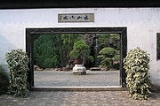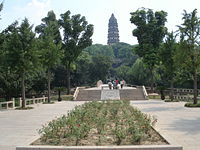
Tiger Hill, Suzhou
Encyclopedia


Suzhou
Suzhou , previously transliterated as Su-chou, Suchow, and Soochow, is a major city located in the southeast of Jiangsu Province in Eastern China, located adjacent to Shanghai Municipality. The city is situated on the lower reaches of the Yangtze River and on the shores of Taihu Lake and is a part...
, in China
China
Chinese civilization may refer to:* China for more general discussion of the country.* Chinese culture* Greater China, the transnational community of ethnic Chinese.* History of China* Sinosphere, the area historically affected by Chinese culture...
. It is a popular tourist
Tourism
Tourism is travel for recreational, leisure or business purposes. The World Tourism Organization defines tourists as people "traveling to and staying in places outside their usual environment for not more than one consecutive year for leisure, business and other purposes".Tourism has become a...
destination and is known for its natural beauty as well as historical sites. The hill is so named because it is said to look like a crouching tiger. Another legend states that a white tiger appeared on the hill to guard it following the burial of King Helü
King Helü of Wu
King Helü of the state of Wu , a state in ancient China, was initially known as Prince Guang . He reigned towards the end of the Spring and Autumn Period.-Biography:...
. The hill is sometimes referred to in parallel with "Lion Mountain", another hill near Suzhou
Suzhou
Suzhou , previously transliterated as Su-chou, Suchow, and Soochow, is a major city located in the southeast of Jiangsu Province in Eastern China, located adjacent to Shanghai Municipality. The city is situated on the lower reaches of the Yangtze River and on the shores of Taihu Lake and is a part...
which clearly resembles a sitting lion.
The hill has been a tourist destination for hundreds, if not thousands, of years, as is evident from the poetry and calligraphy carved into rocks on the hill.
Its features include:
- Sword-Testing Rock: a rockRock (geology)In geology, rock or stone is a naturally occurring solid aggregate of minerals and/or mineraloids.The Earth's outer solid layer, the lithosphere, is made of rock. In general rocks are of three types, namely, igneous, sedimentary, and metamorphic...
in two pieces that was supposedly cleaved cleanly by a legendLegendA legend is a narrative of human actions that are perceived both by teller and listeners to take place within human history and to possess certain qualities that give the tale verisimilitude...
ary swordSwordA sword is a bladed weapon used primarily for cutting or thrusting. The precise definition of the term varies with the historical epoch or the geographical region under consideration...
of extraordinary sharpness - Spring of Simplicity and Honesty: a well that, according to legend, first appeared as a spring to an exhausted monk carrying water up the entire length of the hill
- Yunyan PagodaHuqiu TowerThe Huqiu Tower, or Yunyan Pagoda and Tiger Hill Pagoda, is a Chinese pagoda situated at Changmen in Suzhou City, Jiangsu Province. It has several other names, including the Leaning Tower of China and the Yunyan Temple Tower...
: a pagodaPagodaA pagoda is the general term in the English language for a tiered tower with multiple eaves common in Nepal, India, China, Japan, Korea, Vietnam and other parts of Asia. Some pagodas are used as Taoist houses of worship. Most pagodas were built to have a religious function, most commonly Buddhist,...
seven stories in height whose main architectural feature is its lean; it in fact predates the Leaning Tower of PisaLeaning Tower of PisaThe Leaning Tower of Pisa or simply the Tower of Pisa is the campanile, or freestanding bell tower, of the cathedral of the Italian city of Pisa... - Sword Pond (Jianchi): a small rectangular pond, beneath which a treasure of some 3000 swords are believed to have been buried; this site is not excavated because the Leaning Pagoda's foundations rest on the site
- Lu Yu Well: a well attributed to Lu YuLu YuLu Yu is respected as the Sage of Tea for his contribution to Chinese tea culture. He is best known for his monumental book The Classic of Tea , the first definitive work on cultivating, making and drinking tea.-Biography:...
, author of the first book on tea - Thousand People Rock
History
According to the Historical Records, the Wu King Helu was buried on the hill, called then "the Hill Emerging from the Sea". The legend goes that three days after his burial a white tiger appeared squatting on the hill. Hence the name. It has an elevation of over 30 m. and covers about 49.41ac. Tiger HillTiger Hill
Tiger Hill may mean*Tiger Hill, Suzhou at Suzhou in People's Republic of China*Tiger Hill, Darjeeling at Darjeeling in India*Tiger Hill, Fraserburgh a large sand dune in Fraserburgh.*Tiger Hill, Kargil near the Kargil region of Indian-Kashmir...
boasts impressive rocks, deep dales, 3 matchless scenes, 9 suitable occasions for enjoyment, 18 scenic spots, and changing scenery at all times. No wonder it has been an awe-inspiring sight in the area south of the Lower Yangtze. The Yunyan Temple Pagoda and the Sword Pool are well-known features of the hill. With a history going back more than 1,000 years, the simple, archaic and imposing Yunyan Temple Pagoda, also known as the Second Leaning Tower on earth, stands aloft at the top of the hill, serving as a symbol of ancient Suzhou
Suzhou
Suzhou , previously transliterated as Su-chou, Suchow, and Soochow, is a major city located in the southeast of Jiangsu Province in Eastern China, located adjacent to Shanghai Municipality. The city is situated on the lower reaches of the Yangtze River and on the shores of Taihu Lake and is a part...
for years, The Tomb of the Wu King Helu under the Sword Pool has remained an unsolved mystery for two and a half millennia. The story goes that the great Jin master Wang Xizhi
Wang Xizhi
Wang Xizhi was a Chinese calligrapher, traditionally referred to as the Sage of Calligraphy , who lived during the Jin Dynasty...
traded his calligraphy for lovable geese from the Taoist Abbot. And the windy vale and cloudy spring make the visitor reluctant to leave.

